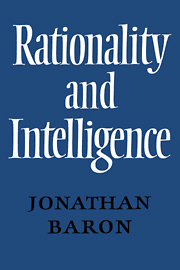Book contents
- Frontmatter
- Contents
- Preface
- 1 Introduction
- 2 Rational choices and plans
- 3 A theory of thinking
- 4 The scheme fleshed out: a decision–theoretic analysis of thinking
- 5 Conditions of effective thinking
- 6 Effects of rational thinking on the individual and society
- 7 The teaching of rational thinking
- References
- Index
7 - The teaching of rational thinking
Published online by Cambridge University Press: 05 October 2009
- Frontmatter
- Contents
- Preface
- 1 Introduction
- 2 Rational choices and plans
- 3 A theory of thinking
- 4 The scheme fleshed out: a decision–theoretic analysis of thinking
- 5 Conditions of effective thinking
- 6 Effects of rational thinking on the individual and society
- 7 The teaching of rational thinking
- References
- Index
Summary
I take teaching to be most narrowly what is done or could be done by teachers and professors. More broadly, it is what is done by parents and peers as well. Still more broadly, we can learn things from anything we do. So, if we are concerned with the promotion of certain kinds of knowledge, dispositions, or abilities, we can take teaching to include any attempt to arrange our environment to promote these things. I take the broadest view in this chapter, although it seems likely that discussion of the issues I raise will have its greatest effect on schools.
My purpose here is to show how the theory I have outlined (particularly in chapter 3) is relevant to the teaching of good thinking. In essence, this theory suggests that teaching should direct itself at the removal and prevention of the major biases: insufficient search (and its total absence), belief perseverance, and confirmatory bias in the search for evidence. I shall first discuss some basic issues: the question of equal opportunity, the question of generality of teaching, the question of developmental readiness. Then I shall sketch an analysis of the various objectives of instruction and the methods used to achieve them. I shall argue that only some of these objectives — principally the inculcation of beliefs and goals — are relevant to the teaching of thinking. This leads to a discussion of the relevance of beliefs and goals in a bit more detail.
- Type
- Chapter
- Information
- Rationality and Intelligence , pp. 244 - 279Publisher: Cambridge University PressPrint publication year: 1985



